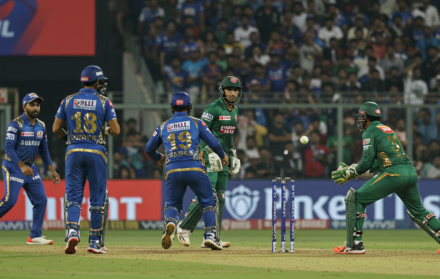
The Most Successful Cricket Strategies and Tactics
Cricket, often seen as a game of finesse and strategy, hinges significantly on the successful implementation of well-thought-out strategies and tactics. The sophistication of modern cricket has led teams and players to continually refine their approaches, whether it’s mastering the art of bowling, field placements, or the crucial reading of pitches. Understanding the rules and scoring of cricket is fundamental, as these regulations frame the tactics employed during the game. This introduction aims to explore the nuances of successful cricket strategies, highlighting how they are essential to triumphing in this complex sport.
An essential component of cricket strategy involves the bowler’s ability to adapt and deliver consistently. Techniques like the swing bowling require not only skill and practice but also an in-depth understanding of the physics behind ball movement. The challenges posed by different pitches and conditions call for a comprehensive ability to read the pitch, which can significantly influence a game’s outcome by affecting decisions on bowling and batting tactics.
On the batting side, mastering specific shots plays a critical role in countering the bowling strategies used by the opposition. For example, the sweep shot against spin bowling is a tactical response that batsmen might use to counteract effective spinners on a turning track. This shot, when well-executed, can not only neutralize the spinner’s threat but also score effectively, making it a vital part of a batsman’s arsenal.
Furthermore, a cricket captain’s ability to deploy smart field placements can stymie the batting side’s efforts and control the flow of runs. Strategic field setting is often as decisive as bowling or batting, requiring an acute understanding of the opposition’s strengths and weaknesses. This tactical aspect is intertwined deeply with the core game strategies and is a testament to cricket’s intellectual demands.
Every cricket match presents a new puzzle composed of variable conditions, opposition strategies, and in-game scenarios. A team’s or player’s success hinges significantly on their adaptability and their continuous effort to improve their game. Practical tips and techniques, such as those provided for players looking to improve their cricket game, are fundamental for anyone aiming to enhance their performance and contribute effectively to their team’s strategies.
Successful cricket strategies and tactics are products of understanding the basics, mastering individual skills, and cleverly manipulating game conditions to one’s favor. Whether through bowling, batting, fielding, or strategic planning, the multifaceted nature of cricket ensures that the most prepared and adaptable players and teams are often the most successful. As we delve deeper into the specifics of these strategies, it’s clear that the intellectual component of cricket is just as significant as the physical, making it a uniquely challenging and rewarding sport.
Aggressive Batting

Aggressive batting is a crucial aspect in cricket and can greatly influence the outcome of a match. It requires specific skills and tactics to excel in this style of batting. There are several key elements that contribute to successful aggressive batting:
1. Choosing powerful shots: Aggressive batsmen are skilled at hitting powerful shots, allowing them to score boundaries and maximize run-scoring opportunities.
2. Being agile on their feet: Aggressive batting necessitates swift footwork to move around the crease and adapt to the strategies of the bowler, enabling the batsman to generate powerful shots.
3. Demonstrating confident aggression: Aggressive batsmen possess a positive mindset, taking calculated risks and aiming to put pressure on the opposing team.
4. Maintaining physical fitness: Exceptional physical fitness is essential for aggressive batting, as it enables players to endure intense periods of play and consistently perform at a high level.
5. Having a variety of shots: Batsmen who excel in aggressive batting must possess a wide range of shots, including lofted shots, sweeps, and innovative strokes, in order to keep bowlers guessing.
6. Building batting partnerships: Successful aggressive batting is often achieved through strong partnerships, effective communication, strike rotation, and capitalizing on each other’s strengths.
7. Timing and aggression: Aggressive batsmen have a sharp sense of timing, utilizing their aggressive intent at the right moment for maximum impact.
By implementing these elements of aggressive batting, players can deliver impressive performances on the cricket field. Batsmen who master this style of batting can become formidable forces, capable of turning matches in their team’s favor through a combination of technique, strategy, and mental strength.
Strategic Field Placements
Strategic field placements are of utmost importance in cricket matches, as they enable captains to optimize their team’s defensive and attacking capabilities, putting pressure on the opposition. Here are some key aspects to consider for effective field placements:
1. Opening positions: It is crucial to place fielders in close proximity to the batsman at catching positions such as slip, gully, and short leg. This increases the likelihood of early dismissals for aggressive opening batsmen.
2. Protecting the boundaries: Fielders should be positioned near the boundary ropes, including long-on, long-off, deep square leg, and third man. This strategy hinders the opposition’s ability to score easy runs, forcing them to take risks.
3. Fielders in the outfield: The strategic placement of fielders at mid-wicket, cover, and extra cover diminishes scoring opportunities through gaps.
4. Spinners and close-in fielders: When spinners are bowling, it is advantageous to have close-in fielders near the batsman, such as short leg, silly point, and forward short leg. This tactic creates pressure and heightens the chances of taking catches.
5. Fielding restrictions: In limited-overs cricket, fielding restrictions apply during powerplay overs where only a limited number of fielders are allowed outside the 30-yard circle. It is crucial to strategically position fielders during this period to limit scoring opportunities.
Field placements can vary based on the match situation, bowler type, and the opposition’s batting style. Captains and teams must continuously assess the game and make adjustments to the field placements in order to create pressure and secure wickets.
Effective Bowling Techniques
When it comes to cricket, bowling techniques are crucial for success on the field. Here are some techniques that can improve a bowler’s performance:
- Swing bowling: Hold the shiny side of the ball on one side and the rough side on the other while releasing it to generate swing.
- Seam bowling: Land the ball on the seam and angle it in different directions to create variations in movement.
- Yorker: A well-executed Yorker targets the base of the stumps. Aim for the batsman’s toes and deliver the ball with precision and pace.
- Slower ball: Disguise a slower-paced delivery by altering the grip and releasing the ball with less force.
- Bouncer: Surprise the batsman with a short-pitched delivery that rises towards their chest or head to force them into an uncomfortable defensive position.
The effectiveness of these techniques depends on various factors, such as pitch conditions, the ball being used, and the bowler’s skill level. Practice, experience, and a thorough understanding of the game are essential for mastering these techniques.
It is worth mentioning that in 1992, during the World Cup semifinal between England and South Africa, a tiebreaker controversy arose. The match ended in a tie, but England advanced to the final based on hitting more boundaries. This incident led to discussions and changes in tiebreaker rules in international cricket.
Intelligent Run-Out Strategies

Intelligent run-out strategies are crucial in the game of cricket as they possess the power to alter the outcome of a match. In this article, we will discuss effective run-out strategies that teams can incorporate to increase their likelihood of dismissing batsmen.
One of the key run-out strategies is to make prompt and precise throws. Fielders should aim to throw the ball swiftly and accurately towards the stumps, reducing the batsman’s time to complete a run.
Another important strategy is to adopt strategic interception angles. Fielders should position themselves strategically to limit the batsman’s ability to complete a run by intercepting the ball effectively.
Direct hits are also vital. Fielders should strive to hit the stumps directly, minimizing the chances of mistakes and increasing the probability of a successful run-out.
Moreover, effective communication between fielders is imperative. Fielders should communicate efficiently with each other to ensure smooth coordination during run-out attempts. This avoids confusion and ultimately leads to successful run-outs.
Teams should also assign backup fielders who are ready to quickly retrieve the ball in case of errors or missed opportunities. This maintains pressure on the batsman and increases the chances of achieving run-outs.
A pro-tip for teams is to regularly practice these strategies during training sessions. By emphasizing quick and accurate throws, interception angles, direct hits, communication, and having backup fielders in place, teams can improve their chances of executing intelligent run-outs in competitive matches. This can ultimately turn the game in their favor.
Skillful Fielding Techniques
Skillful fielding techniques are pivotal for a triumphant cricket team. Considering the following essential techniques:
1. Throwing accuracy: Fielders must exhibit precision while throwing the ball to the wicketkeeper or stumps, aiming for run-outs and creating pressure on the batsmen.
2. Catching prowess: Fielders should possess exceptional skills in catching to dismiss batsmen and prevent runs, both within the infield and outfield.
3. Ground fielding: Fielders need to display proficiency in fielding ground balls and halting boundaries. They should swiftly crouch down, execute clean pickups, and promptly release the ball to deter runs.
4. Boundary fielding: Fielders occupying the boundary must possess anticipation, speed, and agility to adeptly cover the field and save runs.
5. Diving stops: Diving stops have the potential to transform would-be boundaries into dot balls, exerting pressure on the batting side. Fielders should willingly dive and effectively halt the ball.
6. Backing up: Fielders should actively support their teammates, strategically positioning themselves to prevent extra runs resulting from missed catches or errors in fielding.
7. Communication: Efficient communication among fielders is critical for swift and accurate decision-making as well as seamless fielding coordination.
By nurturing these skills, cricket teams can significantly amplify their prospects of success on the field.
Tactical Use of Spin Bowlers
When it comes to cricket strategies, the tactical use of spin bowlers is crucial. Here are some key considerations:
- Match conditions: The decision to use spin bowlers depends on the pitch condition. Spin bowling is effective on dry and dusty surfaces, where the ball grips and turns sharply.
- Variety of spinners: Teams use a combination of off-spinners and leg-spinners for a diverse attack. Off-spinners turn the ball from right to left for right-handed batsmen, while leg-spinners spin the ball from left to right, presenting different challenges.
- Captain’s strategy: The captain plays a critical role in using spin bowlers tactically. They need to decide when to introduce spinners into the attack, considering factors such as the match situation, pitch condition, and strengths and weaknesses of the opposing batsmen.
- Strategic field placements: Fielding positions are planned to maximise the effectiveness of spin bowlers. These positions aim to create catching opportunities, induce false shots and restrict scoring options for the batsmen.
- Bowling plans: Spin bowlers work with their captain to devise bowling plans. This includes analysing the opposing team’s batting lineup, identifying the weaknesses of individual batsmen against spin and exploiting those weaknesses with specific deliveries or variations.
- Role in the middle overs: Spin bowlers often bowl in the middle overs to control the run rate and take wickets. Their ability to vary flight, pace, and spin can frustrate batsmen and create scoring opportunities for the fielding side.
Balanced Team Selection

Balanced team selection is crucial for the success of a cricket team. It involves meticulously selecting players based on their skills, experience, and roles. A balanced team comprises players who complement each other’s strengths and cover all aspects of the game.
To create a balanced team, the following factors should be considered:
1. Batting: Include aggressive batsmen who can score quickly and steady batsmen who can build an innings. The batting line-up should consist of power hitters and technically proficient players.
2. Bowling: Have a well-rounded bowling attack with fast bowlers who can generate pace and swing, spinners who can turn the ball and control the game, and medium pacers who can vary their pace and lengths.
3. All-rounders: Essential for versatility, all-rounders contribute with both bat and ball, adding depth to the team and providing options in various game situations.
4. Fielding: Include players with excellent catching abilities, agility, and throwing accuracy to form a strong fielding unit.
5. Team Dynamics: Consider how players work together as a team. Communication, positive team culture, and the ability to handle pressure situations are important.
By selecting players who meet these criteria, a team can achieve a balanced combination that maximizes their chances of success. Assess each player’s current form, fitness, and past performances when making team selections.
Strategic Use of Powerplays
The strategic use of powerplays in cricket is crucial for teams to gain an advantage over their opponents. Powerplays are limited overs periods in a match where certain fielding and bowling restrictions allow for more aggressive tactics. Here are some essential factors to consider when employing powerplays:
1. Maximize run-scoring opportunities: During the powerplay, the batting team should aim to accumulate as many runs as possible. This can be achieved by sending aggressive hitters to the crease who can exploit the fielding restrictions and score boundaries.
2. Exploit gaps in the field: With a reduced number of fielders in the boundary, the batting team should target the vacant areas on the field. Hitting the ball into these gaps can result in quick runs and create pressure on the opposition.
3. Balance risk and reward: While the powerplay provides an opportunity for aggressive play, teams must also be cautious of losing wickets. Finding the right balance between attacking shots and preserving wickets is vital for a successful powerplay.
4. Capitalize on the middle overs: The middle overs of the powerplay, after the fielding restrictions have slightly eased, offer a chance for steady accumulation of runs. Batsmen should focus on rotating the strike and keeping the scoreboard ticking over.
5. Strategically employ bowling variations: Bowlers should use variations in pace, length, and line to keep the batsmen guessing and prevent easy scoring opportunities. Consistent and accurate bowling can help maintain control over the run rate and create pressure on the batting side.
By implementing these strategies, teams can effectively utilize powerplays to gain an advantage and position themselves for success in a limited-overs cricket match. Thorough planning and precise execution during these critical phases of play can significantly influence the outcome of the game.
Effective Communication and Teamwork
Effective communication and teamwork are crucial for achieving success in any field, and cricket is no exception. It is essential for team members to engage in clear and concise communication, allowing them to share information, strategize, and synchronize their efforts.
Furthermore, active listening and understanding the perspectives of others are equally important aspects. Non-verbal cues, such as body language and facial expressions, play a significant role in effective communication. Trust and respect are also essential for establishing a strong team, as well as having clear roles and responsibilities.
An excellent example of the importance of effective communication and teamwork can be seen in the 2019 Cricket World Cup. The Indian cricket team showcased their exceptional communication and coordination during a crucial match against Australia.
Through their impeccable communication, they were able to execute quick run-outs and make extraordinary catches, which greatly limited Australia’s total and ultimately led to a memorable victory. This story serves as a testament to the profound impact that effective communication and teamwork can have on the outcome of a cricket match.
Adapting to Pitch and Weather Conditions

Adapting to pitch and weather conditions is vital in cricket. Teams can improve their chances of success by understanding and adjusting to these factors. Here are some important factors to consider when adapting to pitch and weather conditions:
- Pitch conditions: It is crucial to analyze the pitch before the game. The condition of the pitch has a significant impact on gameplay. Factors such as grass covering, hardness, and moisture content are important. A dry pitch might assist spin bowlers, while a green pitch may favor seam bowlers.
- Weather conditions: Wind, humidity, and cloud cover can affect the movement of the ball in the air. Batsmen should be aware of crosswinds that could impact their shots. Bowlers can use the wind direction to their advantage by adjusting their line and length.
- Adaptability: Adapting quickly to changing conditions provides a team with a competitive edge. Bowlers should adjust their pace and length based on the conditions. Batsmen should be flexible in their shot selection, considering factors such as swing or uneven bounce.
- Team strategy: Teams must develop a strategy that takes into account the playing conditions. This may involve selecting players with specific skills suited to the conditions or changing the batting order.
- Fielding positions: Fielders should be positioned strategically based on the conditions. For example, in swinging conditions, extra slips or gullies may be used to increase catching opportunities.
- Practice: Regular practice on different pitches and in various weather conditions helps players enhance their skills and adaptability.
Adapting to pitch and weather conditions is essential for successful cricket strategies. By considering these factors, teams can adjust their gameplay and increase their chances of victory.
The Role of Statistics and Data Analysis in Cricket Strategies
The role of statistics and data analysis is incredibly important when it comes to developing successful cricket strategies. Teams can gain valuable insights by analyzing past performances, which in turn informs their decision-making process.
Statistics play a crucial role in helping teams understand the strengths and weaknesses of their players and opponents. By examining batting averages, strike rates, and bowling economy rates, teams can identify key performers and plan accordingly. For instance, if a player has a high batting average against spin bowling, the opposition might consider opting for pace bowlers instead.
Data analysis also assists teams in assessing pitch conditions and the weather forecast, which guides decisions regarding team composition and whether to bat or bowl first. Through analyzing the behavior of the pitch over time, teams can determine which type of bowlers are likely to be the most effective.
Statistical analysis plays a vital part in helping teams set realistic targets during a game. By considering the team’s previous performances and the average scores on that particular ground, teams can make an estimation of a competitive total.
In order to make the most of statistical analysis, teams need to invest in the proper infrastructure and resources. This includes hiring experienced statisticians and data analysts who can accurately interpret the data. Teams must have access to reliable and comprehensive databases that provide up-to-date statistics for informed decision-making.
By integrating the role of statistics and data analysis into their cricket strategies, teams can gain a competitive edge and improve their chances of success on the field.
How Do Teams Analyze Opposition Players and Tactics?
Teams analyze opposition players and tactics in cricket through various methods. Here’s how they gather information and strategize:
- Scouting and research: Teams closely observe opposition players’ performances and gather information about their strengths, weaknesses, and playing styles. They analyze techniques, shot selections, and preferred areas for scoring runs.
- Video analysis: Teams use footage to study opposition players’ techniques and tactics. They analyze footwork, body positioning, and shot execution to identify patterns or vulnerabilities.
- Statistical analysis: Teams rely on data to assess opposition players’ performance and consistency. They study metrics like average runs scored, strike rates, and dismissals to gain insights into batting or bowling prowess.
- Scouting reports: Teams compile detailed reports on opposition players, including key skills and preferred strategies. These reports help create game plans to counter strengths and exploit weaknesses.
- Team meetings and discussions: Coaches, captains, and players analyze opposition tactics and devise counter strategies. They discuss bowling plans, field placements, and batting approaches.
- Practice sessions: Teams simulate different scenarios to prepare for opposition tactics. Bowlers work on specific deliveries to counter a batsman’s strengths, while batsmen practice shot selections to handle specific bowlers or fielding setups.
By analyzing opposition players and tactics, teams can develop effective strategies, gain a competitive edge, and overcome challenges. Study the opposition, focus on strengths and weaknesses, and devise plans accordingly. Effective analysis and preparation greatly contribute to success in cricket matches.
How Do Teams Plan for Different Game Situations?

Teams in cricket have a firm plan in place to effectively handle different game situations. Here are the key strategies that teams employ:
1. Analyzing the situation: Teams carefully assess match conditions, pitch conditions, and the state of the game to fully understand the demands. This analysis is crucial in establishing goals and formulating strategies.
2. Assessing strengths and weaknesses: Teams evaluate both their own strengths and weaknesses, as well as those of their opponents. This helps them identify areas to exploit and areas to be cautious about.
3. Formulating game plans: Based on the analysis, teams develop tailored game plans. This involves determining the batting order, setting fielding strategies, and planning bowling tactics.
4. Adapting tactics: Teams must be flexible and adapt their tactics as the game progresses. They may need to adjust their batting approaches, make changes to field placements, or modify bowling strategies to counter the opposition or take advantage of favorable conditions.
5. Effective communication and teamwork: Communication among team members is vital for successfully executing strategies on the field. Teams must work together, supporting each other and coordinating actions to maximize their chances of success.
6. Assessing risks: Teams carefully consider the risks involved in their strategies and make calculated decisions. They weigh the potential benefits against the potential drawbacks to make the best choices for the team.
7. Learning from past experiences: Successful teams reflect on their performance and learn from past experiences. They analyze what worked well and what didn’t, incorporating these insights into their future strategies.
To ensure success, teams meticulously plan for different game situations, taking into account specific conditions, strengths and weaknesses, and the need for adaptability. By employing these strategies, teams can greatly enhance their chances of achieving positive outcomes.
How Do Teams Approach Batting Powerplays in One-Day Internationals?
Teams approach batting powerplays in One-Day Internationals by adopting a strategic approach in order to maximize their scoring ability. They consider several factors when deciding how to approach the powerplay.
Timing is an important consideration for teams. Typically, they take their powerplay after the first 10 overs when the fielding restrictions are relaxed. This allows the batsmen to play aggressively without encountering too many fielders on the boundary.
Teams also carefully select their batting order during the powerplay. They promote their most aggressive batsmen to take advantage of the fielding restrictions. These batsmen are known for their ability to score quickly and put pressure on the opposing team.
In terms of shot selection, batsmen prioritize playing attacking shots during the powerplay. They aim to hit boundaries and score runs rapidly. They look for gaps in the field and capitalize on loose deliveries.
Running between the wickets is crucial during powerplays. Batsmen need to consistently score runs by swiftly completing singles and converting them into twos. They need to be agile and communicate effectively to seize opportunities to score runs.
Alongside aggression, teams must also exercise caution and assess the risks involved. Batsmen evaluate pitch conditions, the skills of the bowlers, and the overall match situation to avoid unnecessary risks that could lead to wickets.
Teams should adjust their approach during powerplays based on the performance of the opposition, the form of their own batsmen, and the specific match conditions. Analyzing the game situation in real-time and making strategic decisions accordingly significantly enhances a team’s ability to score during powerplays in One-Day Internationals.
How Has Technology Impacted Cricket Tactics and Strategies?
Technology has revolutionized cricket tactics and strategies through the incorporation of advanced statistical tools, video analysis software, and data analysis. These tools provide valuable insights into opposition players and tactics, enabling teams to develop effective game plans and strategies. The use of tools like the Decision Review System (DRS) has improved decision-making accuracy by allowing teams to challenge umpire’s decisions.
Training and practice sessions have been enhanced through the use of virtual reality and simulators, which enable players to practice different strategies and improve their decision-making skills. Performance tracking is now possible through wearable devices and sensors, allowing teams to analyze player performance based on essential information such as heart rate and player movement. This information helps coaches make informed decisions regarding player selection, fitness, and recovery.
Real-time communication devices like earpieces and smartwatches have also improved communication and teamwork between players and coaching staff during matches. Review systems such as Hawk-Eye, Hot Spot, and Snickometer provide accurate information about the trajectory and impact of the ball, aiding players and umpires in making fair decisions.
Technology enhances the viewing experience for fans by providing detailed analysis and replays, allowing them to appreciate the tactical decisions made by teams. Technology has had a significant impact on cricket tactics and strategies, providing valuable insights, accuracy in decision-making, and improved performance tracking. As technology continues to evolve, it will play a vital role in shaping the future of cricket.
What Are Some Famous Examples of Successful Cricket Strategies in History?

Some renowned instances of successful cricket tactics throughout history include:
- Assertive batting: Cricketers such as Sir Vivian Richards and Adam Gilchrist epitomized an assertive batting approach. They initiated attacks on the bowlers right from the beginning, thereby exerting pressure on the opposition and achieving high scoring rates.
- Tactical field placements: Captains like Imran Khan and Ricky Ponting were recognised for their brilliant field placements. They strategically positioned fielders in order to create opportunities for taking wickets and restrict the opposition’s scoring.
- Effective bowling techniques: The fast bowling partnership of Wasim Akram and Waqar Younis for Pakistan is highly esteemed in cricket history. Their lethal combination of swing and pace consistently troubled batsmen and contributed to numerous victories.
- Intelligent run-out strategies: Jonty Rhodes’ famous run-out in the 1992 World Cup against Pakistan serves as an example of an intelligent run-out strategy. Rhodes’ quick reflexes and accurate throws left the opposition astonished and altered the course of the match.
- Skillful fielding techniques: Players such as AB de Villiers and Herschelle Gibbs executed iconic acrobatic catches, showcasing skillful fielding techniques. Their ability to dive and take superb catches significantly enhanced the value of their teams.
These strategies have defined the game of cricket and exhibited the brilliance and innovation of players and captains throughout history.





